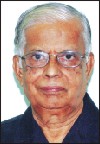Stempeutics Research is India’s leading regenerative medicine (stem cell) company. B N Manohar, its MD and CEO, recently sat down with Deccan Herald’s Georgy S Thomas to explain how regenerative medicines give hope to people who have no other options. Excerpts:

What are stem cells?
The human body is made up of three categories of cells: germ cells, somatic cells, and stem cells. Somatic cells, which have two copies of each chromosome, make up most of the human body. There are 220 types of somatic cells. Germ line cells are any line of cells that give rise to eggs and sperm. The rudimentary stem cells normally transform into somatic cells. But for some reason, some stem cells are still found as leftovers in adults. They have the ability to regenerate other cells. Also, stems cells can be allogenic, which means your stem cell can go to anyone in the world; whereas your blood cannot be of use to others without a match.
When was your company formed?
In 2006.
Who are the promoters?
Manipal Group, initially. Subsequently, in 2009, we entered into a strategic alliance with Cipla. Manipal Group is well known in education and healthcare. What we are doing is novel product development. So we felt the need to have a good pharma partner. Cipla owns 49 per cent equity, and Manipal Group is the 51-per cent majority partner.
How much capital have you raised?
So far around Rs 200 crore. Every quarter, I raise funds from the promoters in proportion to their equity stake.
What are your revenues?
Zero. Today we are still a pre-revenue company and we are likely to generate revenues in this financial year. So far we have been spending money to develop this product for about eight years.
What is the difference between biotech and stem cell technology?
Traditional medicines are derived from chemicals. Biotechnology makes use of biology: you have vaccines, then gene therapy, cell therapy, and tissue engineering. That’s how the whole field is advancing. Ours is a part of biotech, but in a niche area.
Which is the biggest stem cell firm?
There are different biotech and pharma companies entering the stem cell area. The biggest pure-play stem cell company is probably Australia’s Mesoblast. It is not making much of revenues (AUD 23.75 million) yet, but the market value of the listed company is more than a billion AUD, probably in recognition of its potential.
Do you have any competitors in India?
In India, there is Reliance Life Sciences. But it is not focused like us in bringing out a New Biological Entity or NBE. Our NBE is MSC or mesenchymal stromo cell.
How many drugs are you working on?
We are working on only one drug called Stempeucel. Unlike chemicals, stem cells are multipotent. Like the embryonic stem cell which can turn into any of 220 different somatic cells, our MSC derived from bone marrow is pluripotent, meaning it can do multiple jobs in our body.
Which stage is this drug in?
Stempeucel has completed pre-clinical safety tests in animals, and Phase-1 and Phase-2 trials in more than 200 humans. We have now moved the drug controller general of India (DCGI) to directly go into production and marketing by skipping Phase-3. DCGI is actively considering it.
In pre-clinical trials, we had to prove the drug’s safety and efficacy. The safety trials were done at National Institute of Nutrition (NIN), Hyderabad, and Syngene, Bengaluru. While we were doing this, being the first to attempt an NBE in India, we chose to work with DCGI to form a regulatory framework.
Is there a regulatory framework now?
It is there now. Over a period of 7-8 years we worked with the DCGI to create the framework.The guidelines have been published and feedback has been received from the public. Now Parliament will have to amend the Drugs and Cosmetics Act to bring in the changes.
What disease is Stempeucel targeting?
We are focusing on a condition called CLI or critical limb ischemia.
What is it?
Like a heart attack, it is known as leg attack. The arteries get blocked, you will have severe pain and will not be able to walk. Even when you sit, there will be severe pain and any ulcers won’t heal because there is no proper blood flow. Ultimately, it may lead to amputation. More than 10 million people suffer from CLI in India.
Is Stempeucel an injection?
Yes. We give around 40 injections around the leg in a one-time administration, and also around the ulcer.
How many milligrams?
Each one is 0.5 ml, and 2 ml around the ulcer. We have measured at the six-month interval and seen dramatic results. So based on this we went to the government to fast-track the approval process. Something similar to the orphan drug designation (ODD) and ATMP (advanced therapy medicinal product) processes in Europe. Incidentally, we have received both ATMP and ODD approvals.
It seems you have received some patents too. What are they all about?
The patents are for our novel process in making the NBE. We have applied in 18 countries and has so far received patents in seven countries — the US, Australia, China, New Zealand, Singapore, Japan, and South Africa.
How much will a Stempeucel vial cost?
We are yet to finalise the price. For instance, one 100-million cell vial of stem cell drug Prochymal by US company Osiris costs about $15,000. Our goal is to reduce the price to between $2,000 and $3,000.
How many employees are there in your organisation?
Currently 39. The mix is seven PhD biotechnologists, 30 scientists, two medical doctors.
Do you need a fresh infusion of funds?
We are looking for a strategic partner. After receiving ODD and ATMP approvals, we have been asked to do a pivotal trial in Europe. It costs up to $30 million to do even a simple clinical trial there. So we need a bigger partner, preferably a pharma.
What is your five-year goal?
Ultimately, our goal is to provide solutions for major unmet medical needs. For that, we have to be financially strong as well. We hope to become a $100-million company in five years.
source: http://www.deccanherald.com / Deccan Herald / Home> Supplements> Economy & Business / by Georgy S Thomas / DHNS – September 07th, 2015







